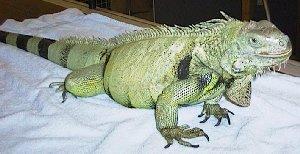Lizard and Snake Taking a History
Introduction
History taking and physical evaluation require a methodical approach. They are the basis for the differential diagnosis list, the selection of diagnostic aids and form the foundation for treatment. The diagnostic workup in an unfamiliar species such as a snake or lizard will hopefully present no problems to the clinician experienced with other animals.
- For information on conducting a physical examination of a lizard, see here.
- For information on conducting a physical examination of a snake, see here.
History taking
A thorough history is an essential part of the clinical examination since most problems are related to inappropriate husbandry. History taking has four parts: signalment, husbandry evaluation, patient health review and presenting complaint.
Clients should be given helpful instructions when making an appointment.
- Clients should be encouraged to keep records: food intake, slough dates, weights and measurements.
- Clients should bring in any records and photos (or videotape!) of the snake's enclosure.
- A history form should be completed by the client (and reviewed by the clinician) prior to the appointment.
- The client should be encouraged to obtain a fresh faecal sample. This can be brought to the clinic prior to or at the time of the physical examination.
- Advise that snakes are best transported in an insulated, warm, dark, secure box or bag rather than wrapped around their shoulders (some other clients will find this amusing but many will be very alarmed and worried for their Yorkshire terriers).
Signalment
As with any animal, obtaining the following information is essential:
- Owner's details
- Previous owners
- Source - home bred, privately bred, pet shop or wild caught
- Length of time owned
- Patient name or number
- Define the species accurately and do not depend on information supplied by the client. Refer to an appropriate encyclopaedia if uncertain.
- Age (may be difficult to ascertain from a physical examination except as juvenile or adult)
- Sex (sexing may be performed as described in physical examination)
Husbandry evaluation
Poor husbandry invariably leads to disease. Check the following:
- Size and type of cage appropriate for species, cage substrate, cage furniture
- Cage mates, other pets
- Heating, lighting, humidity, water
- Diet – as precise as possible
- Cleaning – method and how often
- Handling - how often and how long (e.g. each day for half an hour)
- Checking the reptile – how often
- Records kept
- Recent changes in household
Patient health review
Behaviour
Is the reptile ...
- showing normal activity?
- restless?
- having any unusual muscle tremors?
- lethargic?
- more active, especially at odd times?
- spending more time hiding than expected?
- spending more time in the cooler end of the thermal gradient than expected?
- spending more time in the basking area than expected?
- having prolonged soakings in water bowl?
Food and water
- Has food intake dropped off?
- Is there any change in water consumption?
- Has there been any regurgitation of food?
Faecal and urate production
- Has there been any change in the amount, appearance or consistency of faeces (e.g. less or more in total volume, smaller, harder or drier)?
- The following descriptions may be helpful for the owner: hard, soft, loose, watery, mucousy, bloody, bad odour, black, green, substrate present, hair/feathers present.
- What is the frequency of defaecation?
- When was the last faecal examination performed and what were the results?
- Has there been any change in the amount, appearance or consistency of the urates (e.g. less/more in volume, thicker, more viscous)?
Breathing
- The following descriptions may be used: normal, abnormal, noisy, nasal discharge, squeaks, fast, sneezing, laboured, choking.
Presenting complaint
Obtain the following:
- Why is the animal being presented for veterinary attention? Define the presenting complaint. Many reptiles present with non-specific signs of disease such as lethargy, anorexia and weight loss.
- What is the duration of the presenting complaint?
- Has there been any progression?
- Has this problem occurred before?
- Has anyone already given you any advice?
- Has there been any medication given prior to presentation? The prior use of medication, including parasiticides, should be ascertained.
| This article has been peer reviewed but is awaiting expert review. If you would like to help with this, please see more information about expert reviewing. |
Error in widget FBRecommend: unable to write file /var/www/wikivet.net/extensions/Widgets/compiled_templates/wrt69531213539389_80139694 Error in widget google+: unable to write file /var/www/wikivet.net/extensions/Widgets/compiled_templates/wrt69531213590a94_08351033 Error in widget TwitterTweet: unable to write file /var/www/wikivet.net/extensions/Widgets/compiled_templates/wrt695312135f4356_38228099
|
| WikiVet® Introduction - Help WikiVet - Report a Problem |
